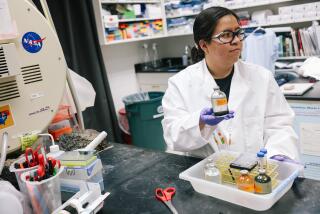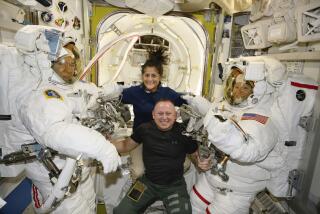JPL Scientist Settling Back to Earth After Shuttle Mission
- Share via
Taylor Wang finally got his Drop Dynamics Module to work after three days of frustration aboard the space shuttle Challenger, so he let out a yell of joy that his fellow astronauts later described to him as the shout heard round the world.
“It’s working! It’s working!” Wang let loose, waking some crew members.
His jubilation was easy to understand.
Wang, a Glendale resident, had waited nine years to test the theories of liquid-drop dynamics in zero gravity with the module he invented, a machine that manipulates free-floating liquid drops with sound waves. Scientists hope the device can be used in development and testing of new or better metals or chemical liquids.
After he got his machine fixed, Wang performed more than 45 hours of experiments.
New Glass, Metal Materials
A physicist at Caltech’s Jet Propulsion Laboratory, Wang was the first scientist chosen to perform his own experiments in space. He was a crew member on the space shuttle flight two weeks ago.
The data he brought back, recorded on more than 14,000 feet of film, is expected to lead to development of new glass and metal materials, such as stronger and lighter aluminum.
But for now, Wang’s exploits have earned him a hero’s welcome. Glendale will honor Wang at a special ceremony during the June 4 City Council meeting. At the ceremony, Wang is expected to make a presentation of the city flag that he took into space.
His Drop Dynamics Module, a $3.5-million chamber seven feet high, blew a power supply before Wang had a chance to start his experiments. With no schematics on board the shuttle, Wang had to follow instructions relayed to him from Johnson Space Center in Houston, where co-workers from JPL were tracking the source of the problem.
It wasn’t until the fourth day of Challenger’s seven-day mission that Wang was able to bypass the failed power supply and hot-wire his machine.
‘Heard From Air to Ground’
“Everybody in the spacecraft heard me yell,” Wang recalled at a welcome home celebration held at the JPL facilities in La Canada Flintridge last week. “They say I yelled so loud, they must have heard it all over the world from air to ground.”
Had Wang not been successful, joked Lew Allen, JPL director, a firing squad would have been set up for his return greeting.
Instead, Wang encountered banners, balloons, a marching band fanfare and a cheering crowd of 250 co-workers. In recognition of his mechanical exploits in space, JPL officials gave Wang a “Mr. Goodwrench” baseball cap and towel--to wipe worry beads of perspiration.
Wang was quick to credit others for what he achieved during his “very eventful week” in space: “I had a very good time. I enjoyed myself very much. But you are the unsung hero in this.”
Since returning to Earth, Wang has been busy attending routine debriefing sessions at National Aeronautics and Space Administration centers in Texas and Alabama. Except for last weekend, he hasn’t been able to spend much time with his wife and two teen-age sons at their home in Glendale.
Scientist Bilingual
Wang has also been attending some not-so-routine press conferences where he has been called upon to answer questions in English and Mandarin Chinese, the 44-year-old scientist’s native tongue. At the JPL celebration, a television news crew from Taiwan relayed Wang’s message to possible future astronauts.
“There is still a lot to learn; still a lot to discover in space,” Wang said in Mandarin. “We’re just barely scratching the surface and I wish they would follow.”
Wang was born in Shanghai, grew up in Taiwan and immigrated to the United States 20 years ago. He paid homage to his origins by designing a patch that he wore on his space suit to resemble the symbol for yin-yang, representing in Chinese philosophy the passive (yin) and active (yang) forces in the universe.
Last week, Wang was honored as one of the first Asians in space as part of Los Angeles’ celebration of Asian-Pacific American Heritage week. Others recognized were Eugene Trinh, a Vietnamese immigrant and JPL scientist who was Wang’s backup for the Challenger flight, and Ellison Onizuka, a Japanese-American astronaut who flew on the Discovery mission in January for the Department of Defense.
Flags in Space
The three were presented with plaques and resolutions from Mayor Tom Bradley. Wang presented the mayor with a Los Angeles city flag that he had taken into space along with the Glendale flag.
A graduate of UCLA, whose blue and gold school colors he used for his patch, Wang has worked at JPL for 12 years.
Wang was one of two professional scientists--the other was Lodewijk van Den Berg of EG&G; Energy Measurements Inc. in Goleta--to perform experiments in Spacelab 3, the orbital laboratory nestled in the shuttle’s cargo bay. The other five crew members are career astronauts. Three of them have scientific backgrounds and assisted in the experiments.
Also along for the ride were 24 white rats and two squirrel monkeys, who inadvertently made life aboard the shuttle a bit unpleasant for the crew. Food and feces escaped from their cages and floated around in the gravity-free atmosphere of the shuttle.
“During the space flight,” Wang said at a NASA-sponsored press conference Monday, “we became very good at batting the feces away.”
Thought About Jettisoning
For Wang, the problem with the animals was the least of his worries while his equipment would not function. As he waited for fix-it instructions from Mission Control, Wang said he was “thinking how to jettison out of that place without people knowing it.”
Wang started to have fun when the module started to work, and he began working 15 hours a day to make up for lost time. Fellow astronauts picked up Wang’s slack in the housekeeping department, taking over his chores so he could work on his experiments.
“I didn’t have to clean up after myself,” Wang said, laughing.
Wang also sacrificed his meal time to work on his experiments. But that didn’t bother him too much, he said, partly because the dehydrated and liquid food was “marginal” and partly because the waste management system (read toilet) was “borderline between civilized and uncivilized.”
“I really didn’t feel like eating very much in that environment,” Wang said.
Earth Experiments
Wang will be participating in future space projects by supervising several experiments from the ground, a JPL spokesman said.
The module is scheduled to make another trip into space in 1987 with Wang or Trinh. Wang would like to go back up but said he would prefer that someone else get a first chance at space travel.
“I’m going to go home and rest for a little while before I worry about my next venture,” Wang said.
But he won’t have too much time to rest. Starting Monday, Wang will be back at his desk at JPL.
More to Read
Sign up for Essential California
The most important California stories and recommendations in your inbox every morning.
You may occasionally receive promotional content from the Los Angeles Times.










